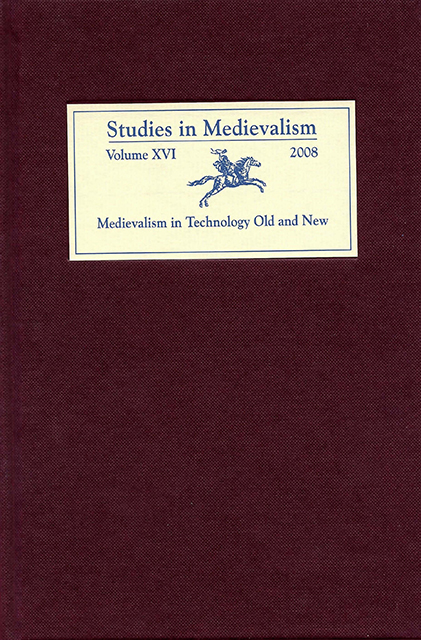Book contents
- Frontmatter
- Studies in Medievalism
- Acknowledgments
- Contents
- Volume XVI 2008
- Illustrations
- Editorial Note
- Contes du Style des Troubadours: The Memory of the Medieval in Seventeenth-Century French Fairy Tales
- A Ritual Failure: The Eglinton Tournament, the Victorian Medieval Revival, and Victorian Ritual Culture
- An Eastern Medieval Revival: Byzantine Art and Nineteenth-Century French Painting
- I Am Weary of That Foolish Tale: Yeatss Revision of Tennysons Idylls and Ideals in Time and the Witch Vivien
- The Doughboy Comes to Chartres: Stars and Stripes and the Middle Ages
- Constructing Difference: The Guidonian Hand and the Musical Space of Historical Others
- An Introduction to Medievalist Video Games
- Medieval and Pseudo-Medieval Elements in Computer Role-Playing Games: Use and Interactivity
- Romancing the Game: Magic, Writing, and the Feminine in Neverwinter Nights
- Revising the Future: The Medieval Self and the Sovereign Ethics of Empire in Star Wars: Knights of the Old Republic
- Promises of Monsters: The Rethinking of Gender in MMORPGs
- Contributors
An Introduction to Medievalist Video Games
Published online by Cambridge University Press: 10 March 2023
- Frontmatter
- Studies in Medievalism
- Acknowledgments
- Contents
- Volume XVI 2008
- Illustrations
- Editorial Note
- Contes du Style des Troubadours: The Memory of the Medieval in Seventeenth-Century French Fairy Tales
- A Ritual Failure: The Eglinton Tournament, the Victorian Medieval Revival, and Victorian Ritual Culture
- An Eastern Medieval Revival: Byzantine Art and Nineteenth-Century French Painting
- I Am Weary of That Foolish Tale: Yeatss Revision of Tennysons Idylls and Ideals in Time and the Witch Vivien
- The Doughboy Comes to Chartres: Stars and Stripes and the Middle Ages
- Constructing Difference: The Guidonian Hand and the Musical Space of Historical Others
- An Introduction to Medievalist Video Games
- Medieval and Pseudo-Medieval Elements in Computer Role-Playing Games: Use and Interactivity
- Romancing the Game: Magic, Writing, and the Feminine in Neverwinter Nights
- Revising the Future: The Medieval Self and the Sovereign Ethics of Empire in Star Wars: Knights of the Old Republic
- Promises of Monsters: The Rethinking of Gender in MMORPGs
- Contributors
Summary
In his 1997 book Cybertext: Perspectives on Ergodic Literature, Espen J. Aarseth argues that the pleasure in reading traditional texts is “the pleasure of the voyeur, safe but impotent.” The reader cannot affect the outcome of, say, a game in such a text, but neither does he or she run any risk from it. That is to say, the barbe of the Green Knight's sword will never threaten the reader's neck quite as literally as it does that of Sir Gawain in their famous “beheading” game.
However, video-game narratives are not traditional texts; they are cybertexts, and they demand a different role from their reader. Indeed, Aarseth argues that cybertext readers may not in fact be readers, for they must also function as co-authors and therefore are not safe. In interacting with narratives, they refashion them and may suffer personal rejection, such as the failure of a quest or even the death of an alter-ego.
Of course, cybertext readers may also enjoy great rewards and may perhaps do so on a far more vicarious level than that of traditional readers. Some of those cyberrewards are tangible within the fiction of the text, such as the gold and jewels that often await at the end of a successful quest. But many of the rewards stem from the interactive experience itself, from having some control over contexts outside of daily modern life.
And that may be particularly true for contexts perceived as being near yet far, as being contiguous enough with our own culture to be at least somewhat familiar, yet as being distant enough to seem at least somewhat exotic, as is often true for the Middle Ages. As Oliver M. Traxel demonstrates below in “Medieval and Pseudo-Medieval Elements in Computer Role-Playing Games: Use and Interactivity,” the Middle Ages, particularly as they have been treated in medieval and post-medieval literature, have enough historical associations and enough common coin in contemporary culture, yet enough ambiguity and association with fantasy, to dominate entire areas of the computer-game industry. Of course, to some degree that success has been fueled by specifically adapting these games to the demands and demographics of desired audiences, as discussed by Amy S. Kaufman in “Romancing the Game: Magic Writing, and the Feminine in Neverwinter Nights.”
- Type
- Chapter
- Information
- Studies in Medievalism XVIMedievalism in Technology Old and New, pp. 123 - 124Publisher: Boydell & BrewerPrint publication year: 2008
- 1
- Cited by

